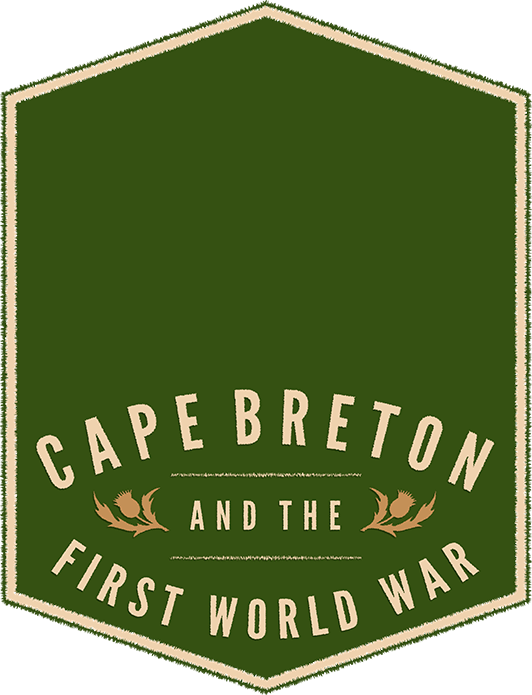Born in North East Margaree in 1893, James Arthur Murphy was the son of James and Julia (Coady) Murphy, farmers of Irish Catholic descent. The fourth child in a family of eight, he went to work in a coal mine at 16. He later returned to his studies and attended St. Francis Xavier University and the Royal Military College in Kingston in 1915. In March 1916, he joined the 59th Battalion as a lieutenant and sailed to England on board the S.S. Olympic the following month.
A Life In Photographs
Explore the photograph gallery below to learn more about James’s life in Margaree, his family, and military service.
Members of the Murphy family of North East Margaree, 1923. James Arthur (pictured at far left) was raised on the family farm in rural Inverness County. He had only a tenth-grade education when the local school closed, and he went to work as a coal miner... Read Full Caption... View Full Screen Image
Members of the Murphy family of North East Margaree, 1923. James Arthur (pictured at far left) was raised on the family farm in rural Inverness County. He had only a tenth-grade education when the local school closed, and he went to work as a coal miner. But his family wanted more for him, and through his mother’s connections—she was a cousin of the Reverend Drs. Moses Coady and James J. Tompkins—he was admitted to St. Francis Xavier University (St. FX) to complete high school. He then went on to the university level and was in his first year when the war broke out in 1914. (Beaton Institute, Cape Breton University, Reference number: MG 20.25 James Arthur Murphy fonds)
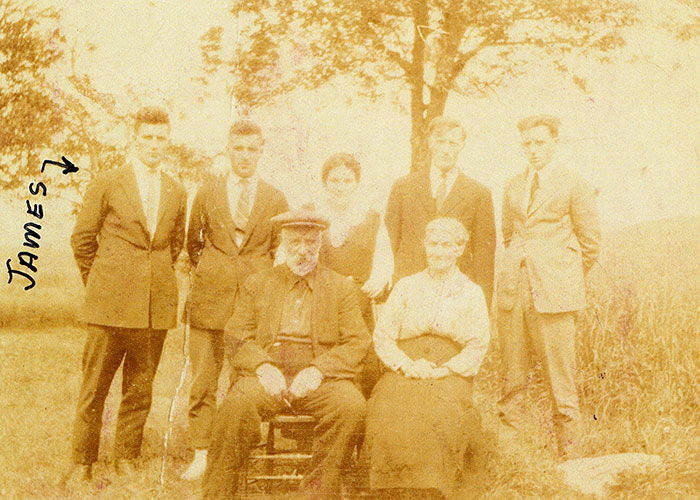
James Arthur Murphy, ca. 1915. Because so many of its senior cadets enlisted in 1914-15, the Royal Military College (RMC) in Kingston, Ontario invited Canadian universities to nominate students for transfer to train as officers in the army... Read Full Caption... View Full Screen Image
James Arthur Murphy, ca. 1915. Because so many of its senior cadets enlisted in 1914-15, the Royal Military College (RMC) in Kingston, Ontario invited Canadian universities to nominate students for transfer to train as officers in the army. St. FX could nominate one candidate, and James was nominated by his mother’s cousin, Reverend J.J. Tompkins, who was originally from Margaree and then Vice-President of St. FX. James attended RMC in 1915-16, Cadet #1105, and was noted to have done exceedingly well in his studies. (Beaton Institute, Cape Breton University, Reference number: 93-213-24187)

Lieutenant James Arthur Murphy, ca. 1916. In March 1916, James travelled from Kingston to nearby Cornwall, Ontario, where he joined the 59th Battalion as a lieutenant and was placed in command of No. 14 Platoon, D Company... Read Full Caption... View Full Screen Image
Lieutenant James Arthur Murphy, ca. 1916. In March 1916, James travelled from Kingston to nearby Cornwall, Ontario, where he joined the 59th Battalion as a lieutenant and was placed in command of No. 14 Platoon, D Company. The 59th Battalion was commanded by Lieutenant Colonel H.J. Dawson, a long-time faculty member of the Royal Military College. It recruited in Eastern Ontario and Hull, Quebec, and sailed for England from Halifax in April 1916 on the SS Olympic. He was later transferred to the 46th Battalion in October 1916. (Beaton Institute, Cape Breton University, Reference number: MG 20.25 James Arthur Murphy fonds)
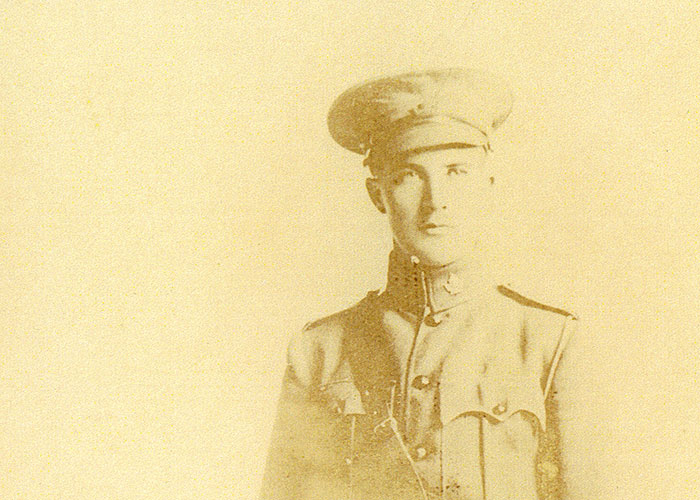
James A. Murphy to father James M. Murphy, France, October 23, 1916. James came from a rural farming community in Cape Breton. The family was Roman Catholic and deeply religious... Read Full Caption... View Full Screen Image
James A. Murphy to father James M. Murphy, France, October 23, 1916. James came from a rural farming community in Cape Breton. The family was Roman Catholic and deeply religious. His correspondence is full of assurances to his mother that he attended mass regularly when he could, went to confession, and even for a time assisted the chaplain with services. This clearly strengthened him while at war, because he accepted the Catholic philosophy that life on earth is only a brief preparation for salvation. His letters frequently display both confidence that he would survive and acceptance of the fact that if he did not, it was God’s will. It seems his parents were not among those Canadians who readily sent their son off to war, and he constantly tried to reassure them that he would survive and return to help with work on the farm. Although he survived the war, he did not in fact return to the farm, and instead forged a new life for himself, initially in Sydney, then in the United States. (Beaton Institute, Cape Breton University, Reference number: MG 20.25 James Arthur Murphy fonds)

A Night Raid. As officer in charge of the 46th Battalion’s “C” Company, James helped plan and lead a trench raid at Souchez, a village nearly three kilometres northwest of Vimy Ridge, which took place in the early hours of February 13th, 1917... Read Full Caption... View Full Screen Image
A Night Raid. As officer in charge of the 46th Battalion’s “C” Company, James helped plan and lead a trench raid at Souchez, a village nearly three kilometres northwest of Vimy Ridge, which took place in the early hours of February 13th, 1917. The purpose of the raid was to destroy enemy tunnels that the Germans had built as part of the extended defences at Vimy Ridge, and was part of the lead-up to the Battle of Vimy Ridge in April, 1917. Thirty-one Canadians were killed in the raid, and many more were injured, including James, who sustained a compound fracture in his left arm. He was awarded the Military Cross for his “conspicuous gallantry and devotion to duty,” but it was the end of his war. After five months in hospitals in France and England, James was repatriated to Canada in July 1917 for further treatment in military hospitals. (Sketch by H.J. Mowat, from the Beaverbrook Collection of War Art, Canadian War Museum, CWM19710261-0431)

Night letter addressed to James M. Murphy, North East Margaree, February 16, 1917. James’s parents received notification that their son had been wounded in action three days after the trench raid at Souchez... Read Full Caption... View Full Screen Image
Night letter addressed to James M. Murphy, North East Margaree, February 16, 1917. James’s parents received notification that their son had been wounded in action three days after the trench raid at Souchez. Several weeks would pass before they received further word about his status. (Beaton Institute, Cape Breton University, Reference number: MG 20.25 James Arthur Murphy fonds)

James A. Murphy to father James M. Murphy, England, May 18, 1917. James’s war proved to be a brief one, consisting of about fourth months in the field, served slightly west of Vimy Ridge... Read Full Caption... View Full Screen Image
James A. Murphy to father James M. Murphy, England, May 18, 1917. James’s war proved to be a brief one, consisting of about fourth months in the field, served slightly west of Vimy Ridge. It is significant but not surprising that, having complained in 1916 about not getting into action, and having proved himself when he got there, he was glad to be out of it. In May 1917, he told his father that his arm was healing “slowly” but “I am not rushing it any as France may be alright but if anyone says that they want to go back have their head examined at once.” (Beaton Institute, Cape Breton University, Reference number: MG 20.25 James Arthur Murphy fonds)

Moxham Military Convalescent Hospital, Sydney, ca. 1918. Following his return to Canada, James continued to recuperate from his injury, and remained under the CEF’s medical care until he was discharged in 1919... Read Full Caption... View Full Screen Image
Moxham Military Convalescent Hospital, Sydney, ca. 1918. Following his return to Canada, James continued to recuperate from his injury, and remained under the CEF’s medical care until he was discharged in 1919. In 1918-1919, he spent five months at the Moxham Convalescent Hospital in Sydney, where he met Captain Henry Verner (85th Battalion) of Louisbourg. The two discussed postwar career options, and along with two other men, established the Cape Breton Engineering Works, later renamed Moore & Murphy Marine, Mechanical and Structural Engineering in Sydney in 1918. Though the business was initially successful, economic depression in the region forced its closure by the early 1920s. (Beaton Institute, Cape Breton University, Reference number: 87-960-17490)
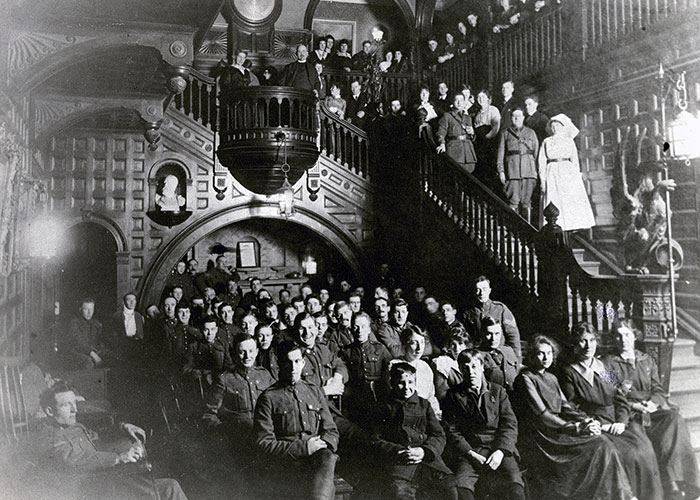
Canadian Expeditionary Force Death Certificate for Private Denny Leo Murphy, issued 1919. James was not the only member of his family to volunteer for service overseas. His older brother Dennis (Denny Leo), who had left Cape Breton before the war, was working as a coal miner... Read Full Caption... View Full Screen Image
Canadian Expeditionary Force Death Certificate for Private Denny Leo Murphy, issued 1919. James was not the only member of his family to volunteer for service overseas. His older brother Dennis (Denny Leo), who had left Cape Breton before the war, was working as a coal miner in Kelfield, Saskatchewan, when he enlisted in Saskatoon in June 1917. He served in the 1st Battalion, Canadian Machine Gun Corps, but was only in the field in France a little over six months when he was killed on October 3, 1918 during the fighting at Cambrai. He is buried in Bucquoy Road Cemetery, near Arras. (Beaton Institute, Cape Breton University, Reference number: MG 20.25 James Arthur Murphy fonds)

Cutting wood at the Murphy farm in North East Margaree, no date. James’s younger brother Martin was living at home and working on the family farm when he was conscripted in June 1918. Despite James's hopes that his brother would be spared from going to war... Read Full Caption... View Full Screen Image
Cutting wood at the Murphy farm in North East Margaree, no date. James’s younger brother Martin was living at home and working on the family farm when he was conscripted in June 1918. Despite James's hopes that his brother would be spared from going to war, he was not exempted, and was sent to Camp Aldershot for basic training. Fortunately for Martin, the war ended before he could be sent overseas, and he was demobilized at Halifax in January 1919. Two other brothers, Ranald and Bernard, were not involved in the war. (Beaton Institute, Cape Breton University, Reference number: MG 20.25 James Arthur Murphy fonds)
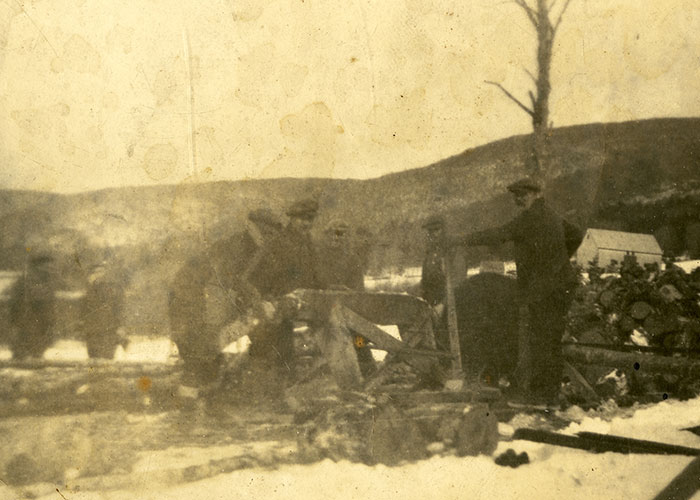
Diploma of Honour issued to James M. Murphy of North East Margaree, 1917. James’s father, James M., was recognized for his efforts and contributions in food production during the war by the National Service of Nova Scotia in 1917. (Beaton Institute, Cape Breton University, Reference number: MG 20.25 James Arthur Murphy fonds) View Full Screen Image

Margaree, ca. 1920. (Beaton Institute, Cape Breton University, Reference number: 81-1412-6492) View Full Screen Image

James and Elizabeth Murphy and their five children, ca. 1940. James met Elizabeth “Betty” MacDonald of Iona in Boston and they married in Roxbury, Massachusetts in 1924. They moved to Michigan in 1927 and had five children. (Beaton Institute, Cape Breton University, Reference number: MG 20.25 James Arthur Murphy fonds) View Full Screen Image

James and Elizabeth Murphy, ca. 1960. (Beaton Institute, Cape Breton University, Reference number: MG 20.25 James Arthur Murphy fonds) View Full Screen Image

Beyond the Shores of Cape Breton

The Canadians in France War Map (Montreal Star Publishing Company, ca. 1918). Map 185.
Of the more than 619,000 Canadians who joined the Canadian Expeditionary Force (CEF) during the First World War, nearly 425,000 went overseas, and more than 61,000 did not come home. Approximately 36,000 of those who served were from Nova Scotia, a suggested 4,500 of whom died in the war. Those who survived were expected to return to civilian life, but for many the transition proved difficult. Some struggled to find work, while others suffered the effects of physical and psychological wounds.
The men who volunteered in the CEF came from a variety of backgrounds. Drawn from rural areas and urban centres across the country, they included doctors, dentists, clerks, farmers, fishermen, miners, and students. The majority were recent British immigrants or men of British background, but there were also men of various ethnicities (including those of Acadian, Mi’kmaq, and African Nova Scotian heritage). They ranged in age from 18 to 45 (with exceptions), and were typically single, religious, and possessed a limited education. Some had previous militia experience, but many did not.
The thousands of Canadians who served overseas left their communities, homes, family, and friends. Their lives would be forever changed, including James Arthur Murphy of Northeast Margaree.
In the trenches

Lieutenant Murphy's Vimy raid orders, with James's handwritten notations, February 9, 1917. MG 20.25 James Arthur Murphy fonds.
“I don’t want to make out that I was a hero. The heroes are pushing up daisies over there.” – James Arthur Murphy, Lieutenant
Once in England, James spent several months instructing physical and bayonet training, but he was anxious to get to France and join the fight in the field. By October his lobbying proved successful, and he was transferred into the 46th Battalion (South Saskatchewan), which was arranged by Lieutenant Colonel Dawson, James’s former professor at the Royal Military College in Kingston.
The 46th was a particularly aggressive battalion that became known as the “Suicide Battalion” because of its high casualty rate: 1,133 killed and 3,484 wounded—a casualty rate of 91.5%—in the 27 months it was in action. In the fall of 1916, the Battalion was sent to participate in the Somme offensive along the River Somme in France. On November 10th, 1916, James was present when the Battalion staged an attack on the Germans at Regina Trench, near Courcelette. Known as the Capture of Regina Trench, it marked the end of the months long offensive, which would prove to be one of the bloodiest and most catastrophic battles of the war.
Three months later, in the early hours of the morning on February 13, 1917, James was wounded in a large brigade assault at Souchez, a village nearly three kilometres northwest of Vimy Ridge. Led by Lieutenant Colonel R.D. Davies, commanding officer of the 44th Battalion, the brigade was comprised of junior officers and men from each of its four battalions (44th, 46th, 47th and 50th), for a total of 320 men. The purpose of the raid was to destroy enemy tunnels that the Germans had built as part of the extended defences at Vimy Ridge, and was part of the lead-up to the Battle of Vimy Ridge in April, 1917. It required the Canadians to pass through three lines of enemy trenches. The fighting was fierce, and casualties were high. Thirty-one Canadians were killed in the raid, and many more were injured, including James. He sustained a very serious injury—a compound fracture in the humerus, the long bone that extends from the shoulder to the elbow—to his left arm and was removed from the field for medical treatment.
Following the raid, Lieutenant Colonel Dawson recommended James for the Military Cross, which was approved in April 1917 for “conspicuous gallantry and devotion to duty. He rallied several raiding parties at a critical time. He displayed great gallantry throughout, and although wounded, by his example and effort rendered invaluable assistance in making the operation a success.” James received his Military Cross from King George V at an investiture at Buckingham Palace on June 30, 1917.
After five months in hospitals in France and England, James was repatriated to Canada in July 1917 for further treatment in military hospitals in Halifax (Camp Hill) and Sydney (City Hospital and Moxham Military Convalescent Hospital). In May 1919 he was posted briefly to the military district depot in Montreal, then was sent back to Halifax where he was demobilized in July 1919.
Library and Archives Canada, Personnel Records of the First World War. “Murphy, James Arthur,” RG 150, Accession 1992-93/166, Box 6510 – 45, page 1. View Full Screen Image
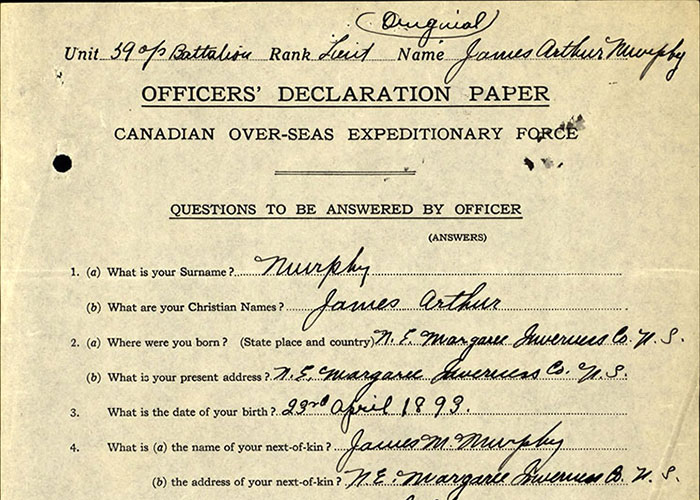
Library and Archives Canada, Personnel Records of the First World War. “Murphy, James Arthur,” RG 150, Accession 1992-93/166, Box 6510 – 45, page 7. View Full Screen Image
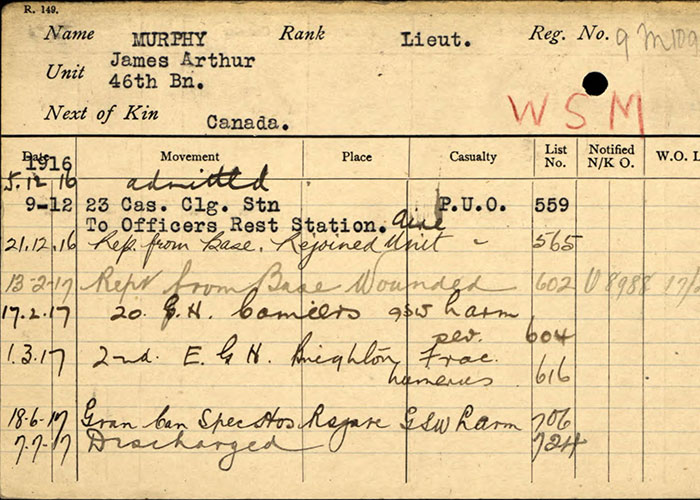
Library and Archives Canada, Personnel Records of the First World War. “Murphy, James Arthur,” RG 150, Accession 1992-93/166, Box 6510 – 45, page 16. View Full Screen Image
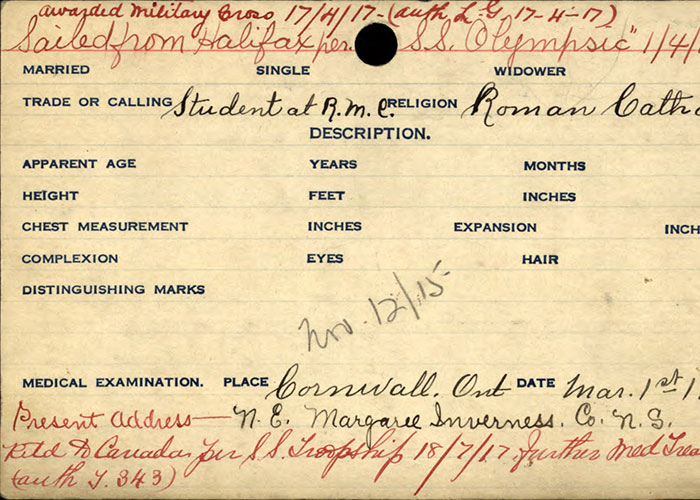
Library and Archives Canada, Personnel Records of the First World War. "McDougall, J.R.," RG 150, Accession 1992-93/166, Box 6788 — 25, page 19. View Full Screen Image

Library and Archives Canada, Personnel Records of the First World War. “Murphy, James Arthur,” RG 150, Accession 1992-93/166, Box 6510 – 45, page 28. View Full Screen Image

Library and Archives Canada, Personnel Records of the First World War. “Murphy, James Arthur,” RG 150, Accession 1992-93/166, Box 6510 – 45, page 31. View Full Screen Image
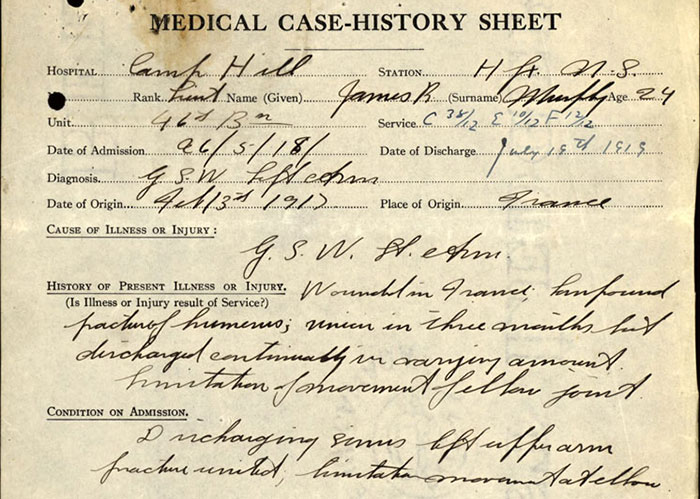
Library and Archives Canada, Personnel Records of the First World War. “Murphy, James Arthur,” RG 150, Accession 1992-93/166, Box 6510 – 45, page 45. View Full Screen Image
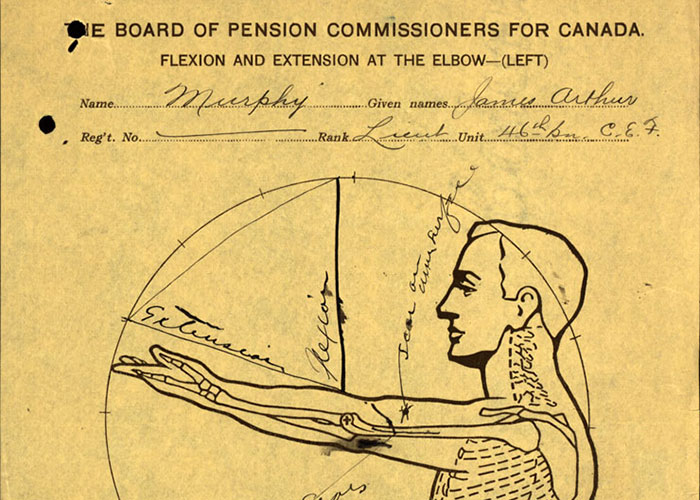
Library and Archives Canada, Personnel Records of the First World War. “Murphy, James Arthur,” RG 150, Accession 1992-93/166, Box 6510 – 45, page 93. View Full Screen Image

Library and Archives Canada, Personnel Records of the First World War. “Murphy, James Arthur,” RG 150, Accession 1992-93/166, Box 6510 – 45, page 94. View Full Screen Image

After Blighty
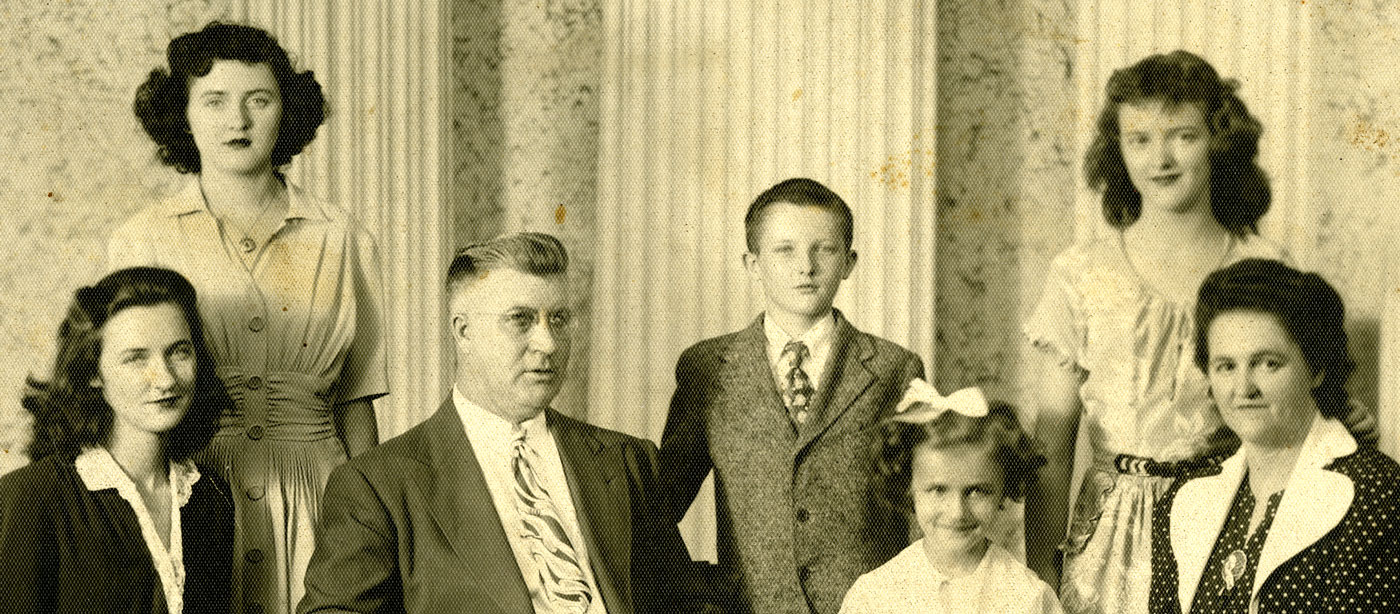
James and Elizabeth Murphy and their five children, ca. 1940. MG 20.25 James Arthur Murphy fonds.
Following the war James returned to civilian life, a transition that proved difficult for many men. Convinced that opportunities existed in repair and construction work, he and three other men established Cape Breton Engineering Works, later renamed Moore & Murphy Marine, Mechanical and Structural Engineering in Sydney in 1918. In 1920, he returned to St. FX, where he enrolled in a two-year engineering program with a view to completing his degree at the Nova Scotia Technical College. A deep economic depression in the region soon set in, however, and the company’s success was short-lived. After its closure, James was forced to seek work elsewhere, and like many Cape Bretoners before him, he left the island and moved to Boston in 1923.
He worked in construction in and around Boston for several years, and later moved to Detroit, where he worked first in a steel mill, then in the Ford and Chevrolet car factories. During the Second World War, he worked at the Naval Ordnance Depot in Detroit, following which he worked in the Budd automotive parts company until his retirement in 1961.
While in Boston James met Elizabeth “Betty” MacDonald of Iona, whom he married in 1924. Together they had five children: Patricia, Kathleen, Julia, James, and Delores. Although they lived in the United States for nearly fifty years, the Murphy’s retained close ties with family in Cape Breton and frequently returned to the island to visit, a tradition which family members continue today. James died in Detroit in 1972, aged 79.
A man from Margaree

Vale of Margaree, September 18, 1904, by Louise McLennan. Wildflowers of Cape Breton, Rare Books Collection, Beaton Institute, Cape Breton University.
James Murphy’s story represents the changing nature of Canadian (and especially Cape Breton) society in the early years of the twentieth century. Born in a rural part of the island where educational opportunities were limited, he sought work (and likely some life experience) away from the family farm. After working as a coal miner for two years, he returned to school with the support of his family and began his service in the military as a lieutenant. But his progress was cut short when he was wounded in the war, and his injury forced him to seek another path. Economic depression and industrial unrest made life difficult in the postwar years, and James’s attempts to further his education and establish a business in that climate proved unsuccessful. Like many others, he left for the United States in search of opportunity and stability. While there, he married, had a family, and worked in the steel and automotive industries until his retirement, and in so doing, forged a new way ahead for himself during a period of great unrest, uncertainty, and change.

"I don’t want to make out that I was a hero.
The heroes are pushing up daisies over there."
James Arthur Murphy
Lieutenant

